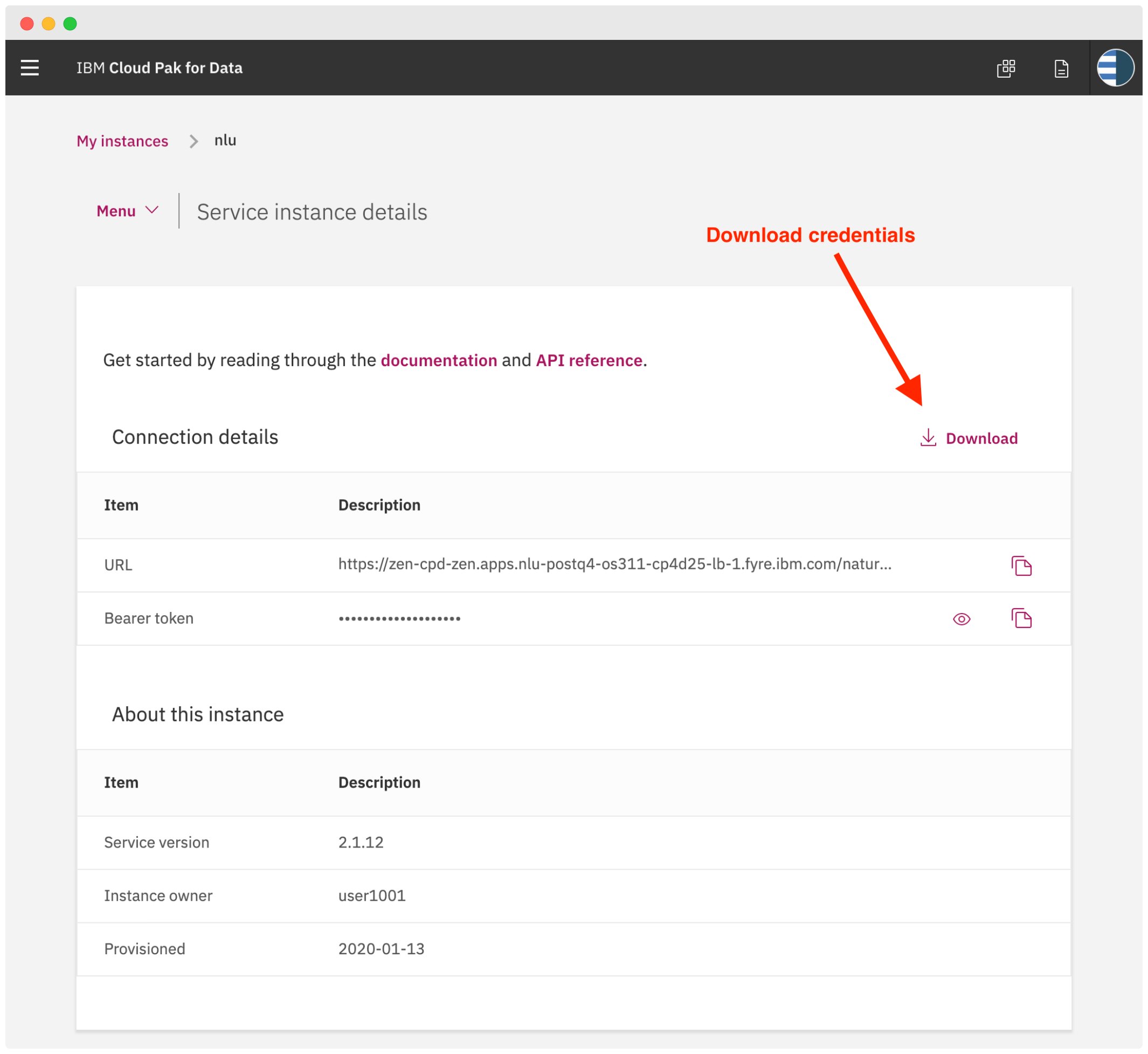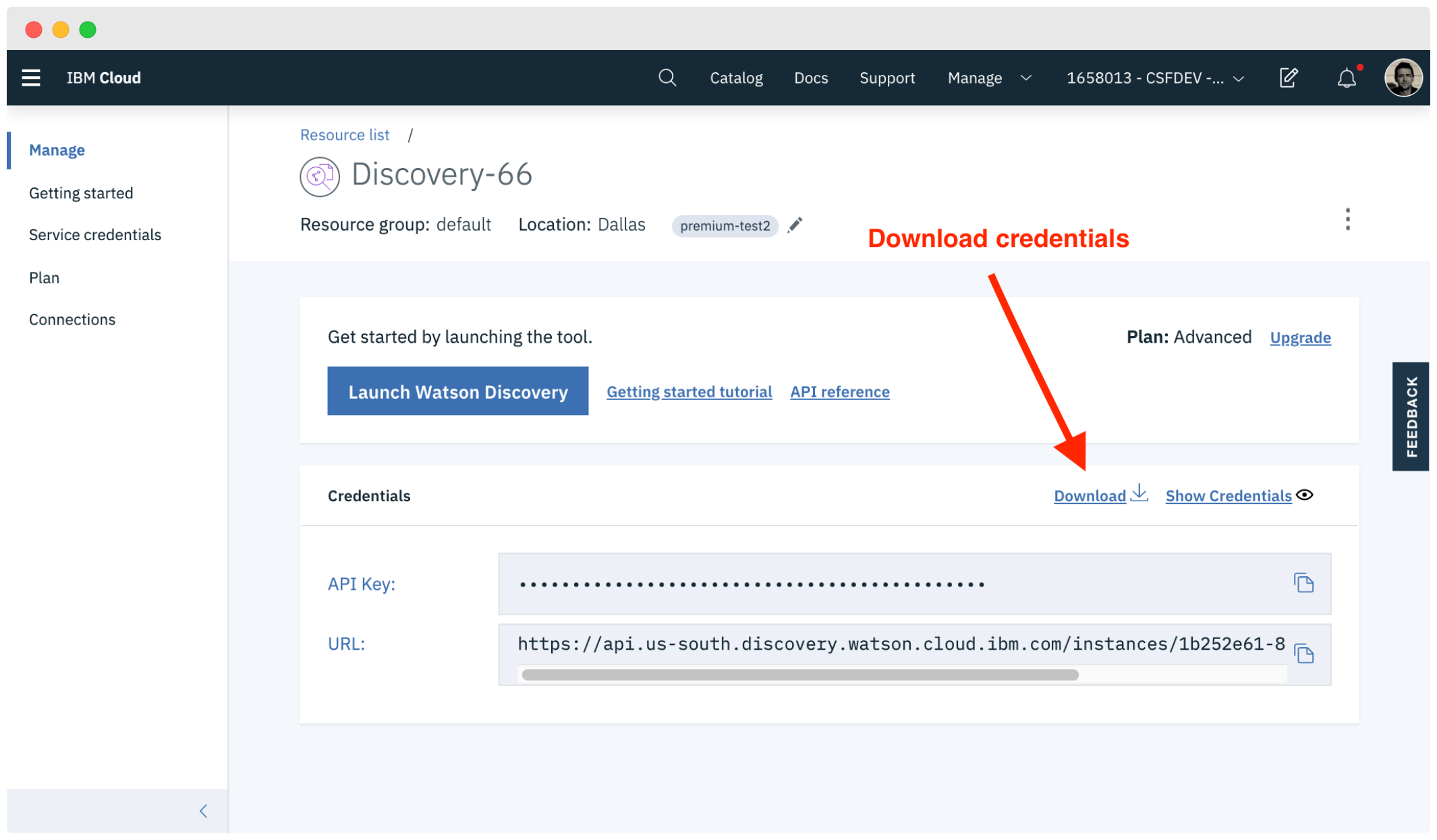This repository will not be updated. The repository will be kept available in read-only mode.
Natural Language Understanding is a collection of APIs that offer text analysis through natural language processing. This set of APIs can analyze text to help you understand its concepts, entities, keywords, sentiment, and more. Additionally, you can create a custom model for some APIs to get specific results that are tailored to your domain.
Demo: https://natural-language-understanding-code-pattern.ng.bluemix.net/
- User sends messages to the application (running locally, in the IBM Cloud or in IBM Cloud Pak for Data).
- The application sends the user message to IBM Watson Natural Language Understanding service.
- Watson Natural Language Understanding processes the text or url and extract features such us keywords, concepts, categories. The service can be provisioned on either IBM Cloud or IBM Cloud Pak for Data.
- Sign up for an IBM Cloud account.
- Download the IBM Cloud CLI.
- Create an instance of the Natural Language Understanding service and get your credentials:
- Go to the Natural Language Understanding page in the IBM Cloud Catalog.
- Log in to your IBM Cloud account.
- Click Create.
- Click Show to view the service credentials.
- Copy the
apikeyvalue. - Copy the
urlvalue.
To use this code pattern with a Natural Language Classifier instance provisioned on Cloud Pak for Data, you can use your CPD username and password credentials or an access_token to authenticate your requests. You also need the service url as described here.
Depending on where your service instance is you may have different ways to download the credentials file.
Need more information? See the authentication wiki.
Copy the credential file to the application folder.
Cloud Pak for Data
Public Cloud
The recommended approach is to download the credentials file and place it in the directory where you code is. Follow the following steps only if you want to manually configure your authentication mechanism.
Configure the authentication manually
-
In the application folder, copy the .env.example file and create a file called .env
cp .env.example .env -
Open the .env file and add the service credentials depending on your environment.
Example .env file that configures the
apikeyandurlfor a Natural Language Understanding service instance hosted in the US East region:NATURAL_LANGUAGE_UNDERSTANDING_IAM_APIKEY=X4rbi8vwZmKpXfowaS3GAsA7vdy17Qh7km5D6EzKLHL2 NATURAL_LANGUAGE_UNDERSTANDING_URL=https://api.us-east.natural-language-understanding.watson.cloud.ibm.com/ NATURAL_LANGUAGE_UNDERSTANDING_AUTH_TYPE=iam-
CPD using username and password: If your service instance is running in Cloud Pak for Data and you want to use
usernameandpasswordcredentials, add theNATURAL_LANGUAGE_UNDERSTANDING_USERNAMEandNATURAL_LANGUAGE_UNDERSTANDING_PASSWORDvariables to the .env file.Example .env file that configures the
username,password, andurlfor a Natural Language Understanding service instance:NATURAL_LANGUAGE_UNDERSTANDING_USERNAME=admin NATURAL_LANGUAGE_UNDERSTANDING_PASSWORD=password NATURAL_LANGUAGE_UNDERSTANDING_URL=https://{cpd-url}:{cpd-port}/natural-language-understanding/api NATURAL_LANGUAGE_UNDERSTANDING_AUTH_TYPE=cp4d NATURAL_LANGUAGE_UNDERSTANDING_AUTH_URL=https://{cpd-url}:{cpd-port}/v1/preauth/validateAuth # Only needed if using a self-signed certificate NATURAL_LANGUAGE_UNDERSTANDING_AUTH_DISABLE_SSL=true NATURAL_LANGUAGE_UNDERSTANDING_DISABLE_SSL=true -
CPD using access token: If your service instance is running in Cloud Pak for Data and you want to use the
access_tokenfrom the service instance detail page.NATURAL_LANGUAGE_UNDERSTANDING_BEARER_TOKEN=eyJhbGciOiJSUzI1NiIsInR5cCI6IkpXVCJ9.ey... NATURAL_LANGUAGE_UNDERSTANDING_URL=https://{cpd-url}:{cpd-port}/natural-language-understanding/api NATURAL_LANGUAGE_UNDERSTANDING_AUTH_TYPE=bearerToken
-
-
Install the dependencies
npm install -
Build the application
npm run build -
Run the application
npm run dev -
View the application in a browser at
localhost:3000
This code pattern can be deployed to any OpenShift cluster running 4.8 or above.
After logging in with oc login, ensure that you have a project set up. If not, create one as follows:
oc new-project nlu-project --display-name="NLU Code Pattern"
Ensure that your current project is set.
oc project nlu-projectRun the deploy.sh script:
sh openshift/deploy.sh
The script will run until the app is deployed and available.
Manually deploy to openshift
The template for this example is located at template.yaml.
First, list the available parameters:
oc process --parameters -f openshift/template.yamlThe output will look like:
NAME DESCRIPTION GENERATOR VALUE
APP_NAME The name assigned to all of the frontend objects defined in this template. nlu-code-pattern
NATURAL_LANGUAGE_UNDERSTANDING_AUTH_TYPE How to authenticate with the NLU service, possible values are: iam, cp4d, bearerToken bearerToken
NATURAL_LANGUAGE_UNDERSTANDING_BEARER_URL The service URL.
NATURAL_LANGUAGE_UNDERSTANDING_BEARER_TOKEN Cloud Pak for Data bearer token.
NATURAL_LANGUAGE_UNDERSTANDING_APIKEY IBM Cloud IAM apikey from the service instance page.
NATURAL_LANGUAGE_UNDERSTANDING_USERNAME Cloud Pak for Data username of user with access to the service instance.
NATURAL_LANGUAGE_UNDERSTANDING_PASSWORD Cloud Pak for Data password of user with access to the service instance.
NAMESPACE The OpenShift Namespace where the ImageStream resides. openshift
APPLICATION_DOMAIN The exposed hostname that will route to the Node.js service, if left blank a value will be defaulted. nlu-code-pattern
SOURCE_REPOSITORY_URL The URL of the repository with your application source code. https://github.com/watson-developer-cloud/natural-language-understanding-code-pattern
SOURCE_REPOSITORY_REF Set this to a branch name, tag or other ref of your repository if you are not using the default branch.
Depending on where your service instance is running you may have to provide different parameters to this application. Follow the instructions on how to run the application locally and create the .env file with the service credentials. The same values will be used when deploying to OpenShift.
Create the template with the values from the previous step.
oc new-app -f openshift/template.yaml --ignore-unknown-parameters=true --param-file ./env
To check the status of the application run:
oc statusWhich should return something like:
In project NLU Code Pattern Project (nlu-project) on server https://10.2.2.2:8443
svc/nlu-code-pattern - 172.30.108.183:8080
dc/nlu-code-pattern deploys istag/nlu-code-pattern:latest <-
bc/nlu-code-pattern source builds https://... on openshift/nodejs:12
build #1 running for 7 seconds
deployment #1 waiting on image or update
An OpenShift route exposes a service at a host name, like www.example.com, so that external clients can reach it by name.
DNS resolution for a host name is handled separately from routing; you may wish to configure a cloud domain that will always correctly resolve to the OpenShift router, or if using an unrelated host name you may need to modify its DNS records independently to resolve to the router.
That aside, let's explore our new web app. oc new-app created a new route. To view your new route:
oc get route
In the result you can find all routes in your project and for each route you can find its hostname.
Find the nlu-code-pattern route and use the hostname to navigate to the newly created Node.js web app.
Notice that you can use the APPLICATION_DOMAIN template parameter to define a hostname for your app.
If the build is not yet started (you can check by running oc get builds), start one and stream the logs with:
oc start-build nlu-code-pattern --follow
Deployment happens automatically once the new application image is available. To monitor its status either watch the web console or execute oc get pods to see when the pod is up. Another helpful command is
oc get svc
This will help indicate what IP address the service is running, the default port for it to deploy at is 8080. Output should look like:
NAME CLUSTER-IP EXTERNAL-IP PORT(S) AGE
nlu-code-pattern 172.30.249.251 <none> 8080/TCP 7m
Run unit tests with:
npm run test:components
See the output for more info.
First you have to make sure your code is built:
npm run build
Then run integration tests with:
npm run test:integration
.
├── app.js // express routes
├── config // express configuration
│ ├── error-handler.js
│ ├── express.js
│ └── security.js
├── package.json
├── openshift // openshift template
├── public // static resources
├── server.js // entry point
├── test // integration tests
└── src // react client
├── __test__ // unit tests
└── index.js // app entry point
This sample code is licensed under the MIT License.
Find more open source projects on the IBM Github Page



